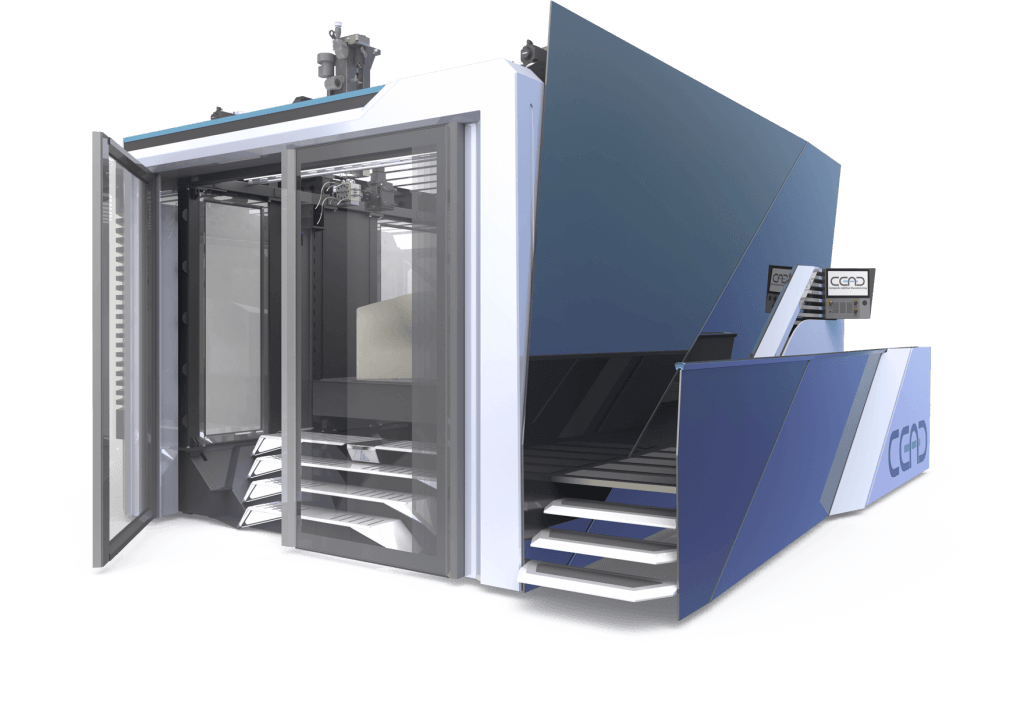As discussed in our series on the role of 3D printing and polymers in (averting or contributing to) ecological collapse, biopolymers may be a crucial factor in the equation to maintain some semblance of post-industrial society that can coexist with life on Earth. Now, the SeaBioComp project has demonstrated the possibilities of 3D printing biopolymers for large-scale industrial use.
The many members of the EU-funded Interreg initiative opted to produce a fender used to protect structures when berthing and guiding ships. In order to replace tropical wood and synthetic plastics in fender construction, the team explored the use of two materials, recycled PETG with glass fiber reinforcement (rPETG-GF30) and thermoplastic starch polymer (TSP).
Project member De Klerk Waterbouw, a specialist in the installation of marine products, outlined the design requirements for the component. This included a width of 400 mm, a base that allows it to slide into an auxiliary structure, an open cavity that can be filled with materials to improve impact resistance and energy absorption.
A sample fender unit made from a combination of TPS and PLA was printed by Dutch composite production company Poly Products using a large-scale 3D printer from CEAD. The structure underwent material testing by the University of Portsmouth and mechanical testing by De Klerk Waterbouw, which reported promising results. The next step is for a further optimization of the design, materials and production process before a full-scale fender is made.

The 3D-printed fender prototype made with a TSP-PLA blended bioplastic. Image courtesy of SeaBioComp.
The findings from the material testing led by the University of Portsmouth and mechanical testing by De Klerk Waterbouw show very promising results and further optimization of designs, materials and production may lead to future full-scale production. This will lead to the installation of a full-scale, 3D-printed fender to test the performance of the structure in the field.
As discussed in our story on TSPs, these materials are difficult to process and brittle at room temperature. Made from starches themselves (as opposed to the lactic acid derived from starches, like PLA), TSPs are usually blended with other plasticizers. In this case, the TSP was mixed with PLA, which has is its own ecological issues but demonstrates strong promise over petrochemical polymers if it can be grown and harvested sustainably.
Because chemical companies are investing in fossil fuel-based plastics (in addition to biopolymers) in part to hedge their bets on a global transition to renewable energy (which also has its own ecological issues), there is a need to demonstrate the viability of biopolymers in large-scale industrial applications. For this reason, researchers from the Singapore University of Technology and Design 3D printed a fully biodegradable wind turbine blade out of chitin and cellulose.
If we can show the world that biopolymers like TSPs can be used to replace traditional petro-plastics, there is the possibility that we can maintain some of the trappings of post-industrial society while relying on more sustainable resources. We are, however, a long way from exhibiting those possibilities. The SeaBioComp project is a small, but important step in showing the applications of 3D printing with bioplastics.
In addition to demonstrating such applications, it will be important to report the lifecycle of these projects, including where and how the materials were gathered, the total lifespan of the items made, and where they end up, as well as shipping emissions and energy used to produce them. The degrowth movement has also shown us that it’s also necessary not just to replace existing materials and production technologies, but to shrink total production and consumption, as Jevon’s paradox can lead so-called sustainable processes to increase total production and consumption activities, simply adding to the total material and emissions footprints of existing fossil fuel-based operations.
Organizations wishing to be informed about the SeaBioComp project can sign up for updates here and reports about the project can be found here.
Subscribe to Our Email Newsletter
Stay up-to-date on all the latest news from the 3D printing industry and receive information and offers from third party vendors.
You May Also Like
Gorilla Sports GE’s First 3D Printed Titanium Cast
How do you help a gorilla with a broken arm? Sounds like the start of a bad joke a zookeeper might tell, but it’s an actual dilemma recently faced by...
Nylon 3D Printed Parts Made More Functional with Coatings & Colors
Parts 3D printed from polyamide (PA, Nylon) 12 using powder bed fusion (PBF) are a mainstay in the additive manufacturing (AM) industry. While post-finishing processes have improved the porosity of...
$25M to Back Sintavia’s Largest Expansion of Metal 3D Printing Capacity Since 2019
Sintavia, the digital manufacturing company specializing in mission-critical parts for strategic sectors, announced a $25 million investment to increase its production capacity, the largest expansion to its operations since 2019....
Velo3D Initiates Public Offering in a Bid to Strengthen Financial Foundations and Drive Future Growth
Velo3D (NYSE: VLD) has been among a number of publicly traded 3D printing firms that have attempted to weather the current macroeconomic climate. After posting a challenging financial report for 2023,...

































